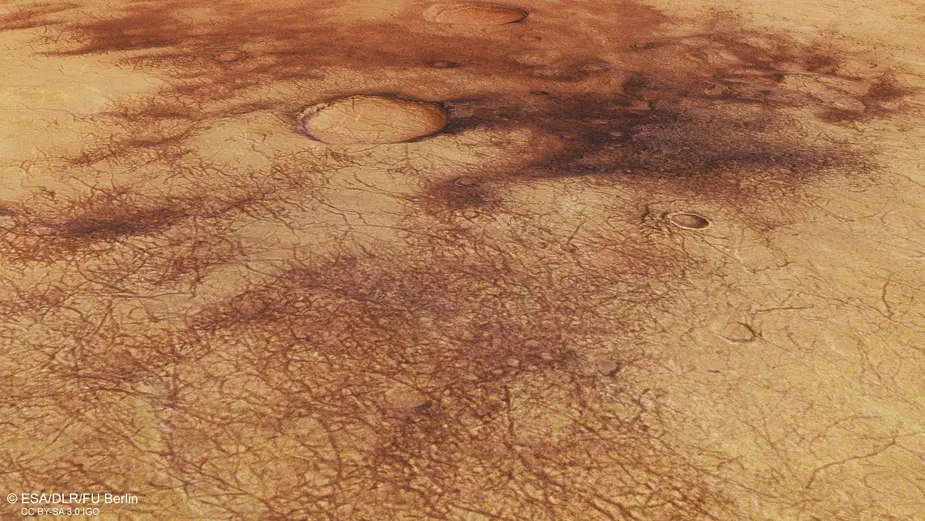Winds blow across Mars at speeds of up to 160 kilometres per hour
New study with DLR participation helps to improve our understanding of the Martian atmospheric dynamics
On Mars, ‘dust devils’ and winds reach speeds of up to 160 kilometres per hour – stronger than previously thought. This is demonstrated by a new study from an international research team led by the University of Bern/Switzerland, with major contributions from scientists at DLR's Institute of Space Research in Berlin/Germany. The researchers analysed images from the Swiss Colour and Stereo Surface Imaging System (CaSSIS) and DLR's High Resolution Stereo Camera (HRSC) using machine learning.
“The study provides a valuable data foundation to better understand atmospheric dynamics on our neighbouring planet,” explains Daniela Tirsch, who leads the HRSC experiment on the European Space Agency (ESA's) Mars Express mission and contributed to the study. “This allows us to develop improved climate models that will also be helpful for future robotic and possibly even crewed missions to Mars.” Despite its very thin atmosphere, Mars experiences winds that play a central role in shaping its climate and the distribution of dust.
Wind movements and the swirling of dust often produce ‘dust devils’ – rotating columns of dust and air that move across the surface in the direction of the prevailing wind. While the wind itself is invisible in images, dust devils are clearly visible. Due to their forward motion, they serve as valuable indicators for research into otherwise invisible wind patterns. Dust devils also occur on Earth, but on Mars they are much larger and can reach heights of several kilometres.
‘Dust devils’ – faster than expected
The study, led by Valentin Bickel from the Center for Space and Habitability at the University of Bern, shows that dust devils and the surrounding winds reach significantly higher speeds than previously assumed. Stronger winds could be responsible for a large proportion of the dust uplift, which has a major influence on the weather and climate of Mars.
In addition to researchers from the Center for Space and Habitability at the University of Bern, the study – published in ‘Science Advances’ – also involved scientists from the Open University in the UK and from DLR's Institute of Space Research.
“The combination of data from the two cameras on the two European satellites opens up a whole range of new research opportunities,” explains DLR planetary geologist Ernst Hauber, who is involved in both camera experiments. “HRSC and CaSSIS complement each other perfectly and together provide a far more comprehensive picture of Mars than a single instrument could – a great example of the strength of international cooperation in space. The resolution of both cameras is high enough to capture even dust devils only a few tens of metres across.”
Investigating with ‘deep learning’
“With the help of a state-of-the-art deep learning approach, we were able to identify dust devils in more than 50,000 satellite images,” explains lead author Valentin Bickel. While the CaSSIS instrument orbits on board ESA’s ExoMars Trace Gas Orbiter and has been delivering image data for more than eight years, the HRSC on board ESA's Mars Express orbiter has been in operation since January 2004. For the next step, the research team examined stereo images of approximately 300 identified dust devils to determine their directions of movement and speeds.
The results show that dust devils and surrounding winds on Mars can reach speeds of up to 44 metres per second – approximately 160 kilometres per hour – across the entire planet. Previous surface measurements had shown that winds usually remain below 50 kilometres per hour and, only in rare cases, reach up to 100 kilometres per hour. “The identification and measurement of all the dust devils in the HRSC data in order to train the algorithm was quite a laborious task,” recalls DLR cartographer Antonia Schriever, looking back on the investigation. “But seeing the results – just how large and fast these whirlwinds actually are – made all the effort worthwhile!” Daniela Tirsch summarises DLR's contribution to the study: “Thanks to HRSC's unique ability to observe the Martian surface using multiple image channels at slightly different times, it became possible to analyse the speed and direction of the dust devils.”
Their high speeds, in turn, influence the dust cycle on the Red Planet. “Strong, non-rotating winds are very likely to carry substantial amounts of dust into the Martian atmosphere – much more than previously assumed,” explains Valentin Bickel. “Our data shows where and when these winds are strong enough to lift dust from the planet's surface – the first time such insights have been available for a period spanning about two decades.” The HRSC has been in operation since January 2004, while CaSSIS has been delivering image data from Mars for more than eight years.
Publication:
Science Advances (2025): Dust Devil Migration Patterns Reveal Strong Near-Surface Winds across Mars
Valentin T. Bickel, Miguel Almeida, Matthew Read, Antonia Schriever, Daniela Tirsch, Ernst Hauber, Klaus Gwinner, Nicolas Thomas, Thomas Roatsch
DOI: 10.1126/sciadv.adw5170
Related links
- HRSC – High Resolution Stereo Camera
- ESA's Mars Express mission
- Center for Space and Habitability (CSH) at the university of Bern
- CaSSIS – Colour and Stereo Surface Imaging System
Contact:
German Aerospace Center (DLR)
Institute of Space Research
Rutherfordstraße 2, 12489 Berlin
Dr. Daniela Tirsch
Principal Investigator HRSC
Ernst Hauber
Planetary Geology
Falk Dambowsky
Head of Media Relations
+49 2203 601-3959
DLR press release, 8 October 2025
